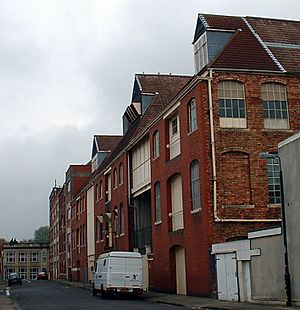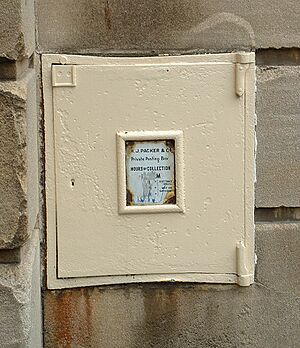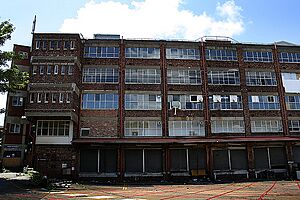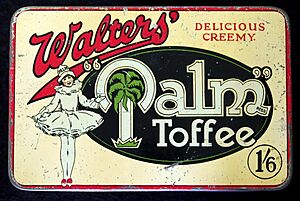Elizabeth Shaw (confectionery company) facts for kids

The Elizabeth Shaw chocolate factory on Co-operation Road
|
|
| Private | |
| Industry | Confectionery |
| Founded | 1810 (Ewbanks) |
| Headquarters | Bristol, United Kingdom |
|
Key people
|
James Goldsmith, (chairman) |
| Products | Famous Brands & Elizabeth Shaw |
| Parent | Colian Holding |
Elizabeth Shaw Ltd. is a company from Bristol, UK, known for its delicious chocolate treats. They make popular sweets like Famous Names liqueur chocolates and Elizabeth Shaw Mint chocolates. Today, the company is owned by Colian Holding. The modern Elizabeth Shaw company was created by combining several older sweet-making businesses. This happened first with a company called J A & P Holland, and later with James Goldsmith's big food company, Cavenham Foods, in the 1960s.
Contents
- Sweet History: How Elizabeth Shaw Began
- Ewbanks: Liquorice from 1810
- S. Parkinson & Sons: The Butterscotch Inventors
- Yeatman & Co: From Yeast to Jelly
- H J Packer & Carsons: Bristol's Chocolate Makers
- Walters Palm Toffee: A Toffee Factory
- Fillerys Toffees: Efficient Sweet Making
- The Original Elizabeth Shaw Company
- Hollands of Southport: The Toffee Kings
- Cavenham Confectionery Ltd: A Sweet Empire
- From Famous Names to Elizabeth Shaw Today
- The Greenbank Factory Site Today
- Archives
Sweet History: How Elizabeth Shaw Began
Elizabeth Shaw's story is like a puzzle made of many different sweet companies. Let's look at some of the important pieces!
Ewbanks: Liquorice from 1810
The Ewbanks story started way back in 1810. It began as Firth Confectioners in Pontefract, making Pontefract cakes, which are a type of liquorice sweet. The company changed hands a few times. In 1887, it moved to a bigger factory called Eagle Liquorice Works. The business was bought by Hollands of Southport in 1961. The Eagle Liquorice Works closed in 1965 after becoming part of Cavenham Confectionery.
S. Parkinson & Sons: The Butterscotch Inventors
Doncaster's famous sweet is butterscotch, and it's said that Parkinsons invented it in 1848! Samuel Parkinson, a grocer, started the company in Doncaster. They called their butterscotch Royal Doncaster Butterscotch or the Queen's Sweetmeat. By 1956, the company had over 500 employees and made many kinds of Parkinsons Boiled Sweets. Hollands of Southport bought this company in 1961 too.
Yeatman & Co: From Yeast to Jelly
Yeatman & Co started in 1857, selling yeast powder. Over time, they made many different products. These included baking powders, different flours, and even insect powder! By 1898, they also made soups, jams, jellies, and sweets. Their Yeatman's Delicious Jelly Tablets were sent all the way to Australia and New Zealand. They even made the first sweets for Marks & Spencer. Their factories were destroyed during the Blitz in World War II. They opened a new factory in Watford, making canned fruits, fruit squashes, and sweets like Goodies and Selesta. Their most remembered product was Sunny Spread. This business was sold in 1964 and became part of James Goldsmith's Cavenham Foods.
H J Packer & Carsons: Bristol's Chocolate Makers
This company started in Bristol in 1881. It was first called H. J. Packer & Co. In 1901, the company moved to a new, specially designed factory in Greenbank. Their sales grew a lot, partly because of their "Two ounces per penny" chocolates for children. They also had popular sweets like Packers Chocolate Mixers.
In 1908, they bought a fancy chocolate maker from Glasgow called Carsons. They also created a new brand, Bonds of Bristol, for luxury chocolates. By the early 1920s, this company was the 4th largest chocolate maker in Britain! They had over 2000 employees. Carsons Chocolate was even taken by Sir Ernest Shackleton on his famous expeditions.
However, the company faced difficulties by World War II. In 1955, they brought out new products like Summit chocolate bars and penny sweets such as White Mice and Sweet cigarettes. By 1961, all Carsons' production moved to Greenbank. Carsons was the biggest British maker of chocolate liqueurs, sold under the Famous Brands name. In 1962, H J Packer was renamed Carsons Ltd. In 1964, James Goldsmith bought the company, and it became one of the first businesses in his big company, Cavenham Foods.
Walters Palm Toffee: A Toffee Factory
Walters Palm Toffee was started in 1887 in Poplar, London. It was founded by Nathan Baraf Walters. Their main product was called "Palm Toffee" because it used palm butter. The company moved to a bigger factory in Acton, London in 1926. By 1935, about 800 people worked there. In 1960, J A & P Holland bought the company.
Fillerys Toffees: Efficient Sweet Making
Fillerys Toffees began in Birmingham in 1923. Their factory grew very large and worked 24 hours a day by 1930. During World War II, the factory made things for the war effort instead of sweets. Other companies, like Rowntree's, made Fillerys' products. This company was very good at making sweets efficiently. They made own-brand products for big stores like Woolworths and Marks & Spencer. In 1960, J A & P Holland bought Fillerys.
The Original Elizabeth Shaw Company
Elizabeth Joice and her husband Patrick started a small sweet business from their home in 1937. They made honeycomb mint-flavoured crisps. They named the business after Elizabeth and used "Shaw" from her old employer. These sweets were soon called Mint Crisps. By 1939, they opened a new factory in Brentford called Mint House. The business grew and offered new products like Mint Creams. In 1968, Cavenham Foods bought the business, and production moved to the Greenbank factory.
Hollands of Southport: The Toffee Kings
In the 1890s, John Holland found a new way to make creamy toffee in Southport. His best-selling product was Everton Toffee. His sons, John Arthur Junior and Peter, took over the business in 1952. The company changed its name to J A & P Holland.
The company grew by buying other sweet companies. They bought Coq D'or Chocolates in 1959. Then came Fillerys Toffees in 1960, and Walters Palm Toffee. By 1961, they had bought over 20 companies! The Daily Mail newspaper even called Holland the world's biggest toffee maker.
John Arthur Holland Junior invented a soft toffee in 1963. It was launched as Chewzits, which later became the famous Chewits. However, the company faced problems, and in 1965, James Goldsmith's Cavenham Foods took over the business.
Cavenham Confectionery Ltd: A Sweet Empire
When James Goldsmith created Cavenham Confectionery, he brought together many companies. These included Carsons, Yeatmans (makers of Goodies and Selesta sweets), J A & P Holland (Britain's biggest toffee maker), and Paramount Laboratories (makers of Cadet Sweet sweet cigarettes).
Besides Famous Names, the new company made many other popular sweets. These included Chewits, Hollands Toffee, Fillery's Toffee, Walters Palm Toffee, Ewbanks Liquorice, Dr Who & The Daleks Sweet Cigarettes, Royal Doncaster Butterscotch, and Parkinsons Boiled Sweets. Cavenham Confectionery closed many smaller factories and focused production at the Greenbank site, Holland's Southport factory, and Parkinsons' Doncaster factory.
In 1967, Cavenham Foods partnered with Perrier's sweet business, which included brands like Menier and Lindt. In 1968, they bought the brand and recipes for Elizabeth Shaw. Later, in 1981, the people who managed Cavenham Confectionery bought the business for £8 million. They changed the business name to Famous Names Ltd.
From Famous Names to Elizabeth Shaw Today
When the management team bought the business, it made 44% of all chocolate liqueurs and 50% of all chocolate mints in the UK. In 1988, the managers bought the business again and renamed it Elizabeth Shaw Ltd. The Famous Brands name was no longer used. In 1990, a Finnish sweet company called Leaf bought the business.
In 2006, Elizabeth Shaw's chocolate business was bought by Nói Síríus, the biggest sweet maker in Iceland. That same year, the company moved its manufacturing to other factories in the UK and Europe. The old 105-year-old factory in Greenbank closed. A Norwegian company, Imagine Capital, bought the business in 2009. In 2016, Colian Holding, Poland's largest sweet manufacturer, bought Elizabeth Shaw from Imagine Capital.
The Greenbank Factory Site Today
The old Elizabeth Shaw factory in Greenbank, Bristol, closed in 2006. In 2013, people living nearby successfully argued against turning the closed factory into flats and houses. They felt the building was an important part of Bristol's history. This opposition was supported by George Ferguson, who had helped turn an old tobacco factory in Bristol into a popular arts center.
By late 2013, the building was still empty. New plans for development were being made. In August 2014, the new owners, Generator South West, seemed ready to start a new project. They held a public meeting to hear what local residents thought. The plan was to create open spaces around new flats and houses.
By 2016, there were still problems with the development. The developers asked to be excused from a rule that 30 to 40 percent of any new homes should be social housing. They said the extra costs of fixing the old, historic buildings made it too expensive. A community group called ACORN campaigned against this. They wanted more social housing because of the housing shortage in Bristol. The developers worked with Bristol City Council to make sure 36 shared ownership homes were built alongside the private housing. The first homes were ready for people to live in by 2021.
Archives
Records about Elizabeth Shaw Limited, especially about the Greenbank factory, are kept at Bristol Archives. This collection also has some records from other companies linked to Elizabeth Shaw Limited. These include HJ Packers, Carsons Ltd, Cavenham Confectionary Ltd, Hollands Toffees, and Huhtamäki. You can find more information in their online catalogue (Ref. 43258).





